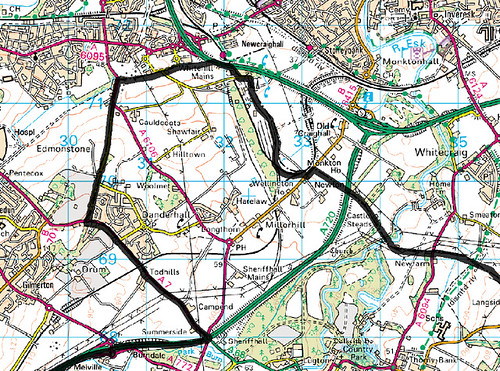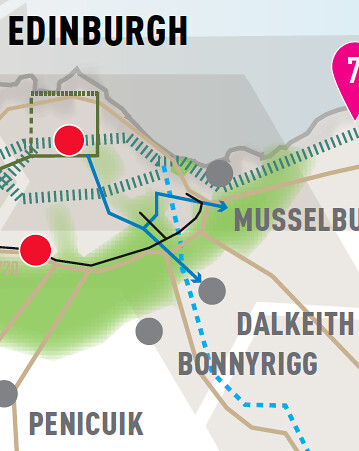This is almost a response to the Ernst & Young report - but was published in the Sunday Herald on 24.02.13 - can't find online.
Extract from below
"In a paper last December, Flyvbjerg crit-
icised "garbage" cost-benefit forecasts as
damaging to public trust"
Business focus
On the right track... will the Borders Railway be worth it?
AS WE AWAIT THE FINAL BUSINESS CASE FOR THE LATEST MAJOR CAPITAL PROJECT, COLIN DONALD ASKS HOW MUCH WE CAN TRUST THE FIGURES
IN the ideal world envisaged
by Professor Bent Flyvbjerg of
Oxford Business School, next
week's promised publication of
the final business case for the
Borders Railway would launch a
public debate on the £350 million
scheme's balance of benefits to Scotland.
In this scenario, which exists in Flyvb-
jerg's native Denmark, ministers and
officials would be standing by to defend
their claims in open public debate, while
civil servants staked their careers on
ensuring the claimed benefits were deliv-
ered, and for a price in line with similar
projects the world over.
Such assumptions and transparency,
and cost appraisal, have not so far been
the Scottish way. Just look at our cata-
logue of mis-sold and over-priced capital
projects, from the Scottish Parliament to
the Edinburgh Trams to the M74 and the
new Forth Crossing, the last two among
the most expensive structures of their type
in the world.
In a paper last December, Flyvbjerg crit-
icised "garbage" cost-benefit forecasts as
damaging to public trust, just as the bank-
ing and food scandals have been. "Merely
firing the forecaster may be letting them
off too easily," he wrote. "Some forecasts
are so grossly misrepresented and have
such dire consequences that we need to
consider suing them for the losses incurred
as a result. In a few cases where forecasters
foreseeably produce deceptive forecasts,
criminal penalties may be warranted."
The Borders Railway is a prime candi-
date for the up-front appraisal Flyvbjerg
advocates. Intended to "ensure that for the
first time in over 40 years, people living in
the Scottish Borders and Midlothian can
benefit from a direct rail link to the capital
city and the wider Scottish rail network",
the project has both strong local support
and strong opposition.
Originally due to open in 2008 for £155m,
the Borders project has been shunned by
investors since it was first mooted 20 years
ago. Plans for a Not for Profit Distribution
(NPD) model failed as prospective inter-
national bidders melted away, causing
ministers to turn to Network Rail, which
last November engaged BAM Nuttall as
construction partner Advance work is
already under way.
Having slipped a revised reopening
date of 2011, the rebuilt 35-mile train line
between Edinburgh and Tweedbank, south
of Galashiels, now has a start-up date m
2015. with the all-in headline capital cost
at £350m, at 2012 prices. Like the dramatic
increase in the price of the new Forth
Crossing during its long gestation, such
rampant price inflation supports Flyvb-
jerg's case for a rethink in Scotland.
Not that increased cost is in itself an
argument against the Borders Railway.
New rail is nearly always good news.
Projects like the Airdrie-Bathgate and the
Stirling-Alloa-Kincardine lines are among
the most tangible successes of devolved
Scottish government.
More in question is the competence,
transparency and accountability with
which calculations of economic benefit
are made. In other words: can Scottish offi-
cials make a credible case for spending this
amount of money at this time?
According to former Borders councillor
Nick Watson, who launched a local politi-
cal party to oppose the scheme "Unless
questions about cost and benefit can be
clearly answered there is no way such a
giant project should be advanced, particu-
larly in times as hard as these."
Some Borderers agree, seeing the line as
badly-sited, potentially damaging to the
environment, lethal to existing bus serv-
ices, and too slow and infrequent to garner
the estimated 647.000 annual return ticket
users A now housing boom along the route
is even less probable now than at the time
of the project's conception. Opponents
have suggested building the line as far as
the Midlothian village of Newtongrange.
and assessing demand before proceeding
to rebuild the rural line
Peter Smaill. a local venture capitalist
with experience of the rail industry, claims
"no reasoned debate has been possible due
to the emotional power of rail projects
and the refusal of Transport Scotland to
respond fully and openly to information
requests".
In contrast, Graham Bell, chairman of
the Federation of Small Businesses in the
Borders, argues that the case has been
made, and that the railway would reveal
the appeal of the area's excellent tourist
environment, schools and quality of life
"Too much emphasis is placed on initial
cost as the only measure of value. Rail
ways in the UK have always struggled to
repay their capital investment. Their true
value has always been as tools of economic
development and cultural change"
But Bell concedes that the line ""really
only makes sense when the route is fully
restored to Carlisle - reinstating Edin
burgh's main route south to the west coast
mainline and beyond"
TRANSPORT Scot
land can explain the
budget increases,
saving that "the scope
of the scheme has been
enhanced to accommo
date important economic
• the original propos
idditional cost for
future-proofing the track for possible
electrification, extending platforms to
accommodate longer trains, "passive
provision (dual track in places) to allow
for four trains per hour for Midlothian
sta ions should demand exceed forecast
and improved station and park-and-ride
facilities to improve connections with
other transport modes."
Similar to the final business case
clouds of official-speak have obscured the
project's risk profile, though the Sunday
Herald has identified three major "known
unknowns" that could burst the current
plans (see panel).
Transport Scotland has stressed that
the budget includes a contingency fund
for things going wrong, or "risk pot"
as the agency's head of major projects
Ainslie McLaughlin described it to the
Scottish Parliament in December.
Asked, understandably, "What happens
if we go over budget?". McLaughlin
responded that the contract "includes I
provision for risks given the continued j
uncertainties due to mine and earth- :
works along the route".
"There are a lot of old structures and
there has been quite a lot of investigation
Into what state they are in but, until the
construction goes ahead, the entire extent
of the work required will not he known
[emphasis added]."
Transport Scotland has since declined
to quantify this emergency kitty, but as
the Scottish Parliament building and
Edinburgh Tram budgets Included "risk
pots", the existence of a fund is not in
itself much comfort.
Transport Scotland's revised busi-
ness case must therefore show that the
project is not, as previous versions were,
dependent on heroic predictions of house-
building along the line. Instead, it will
emphasise issues of "accessibility, social
inclusion and regional equity".
Although Transport Scotland will make
"redactions" for commercial reasons, the
document is expected to show the work-
ings behind its passenger estimates,
assumptions of £33m of economic bene-
fits and insistence on the line's eventual
profitability.
These will be studied closely by econo-
mist Tony Mackay. former lecturer in
econometrics and mathematical econom-
ics at Aberdeen University, one of very few
people in Scotland who understands the
"agglomeration productivity aggregate
response calculator" (APARC) on which
Transport Scotland rests its business case.
He has not been impressed so far.
"A few years ago I undertook a review of
|thc Borders Railway project |. concluding
it would not be economically viable and
would be a poor use of public funds. Noth-
iin: lias happened since then to change
my mind In fact, the project's economics
have almost certainly got worse.
"Public funds are very limited They
should be trying to make the best use
of their funds but the evidence suggests
they are not."
Mackay agrees the railway would benefit
the Borders, just not enough to merit the
expenditure of £350m. "I am very surprised
that Transport Scotland thinks this is a
viable project. It looks increasingly like the
next fiasco after the Edinburgh Trams."
Mackay has broken a taboo of Scottish
public life, by suggesting - given the sums
and the opportunity costs involved - that
well-paid and pensioned civil servants
advising ministers on spending priorities,
should have their "ownership" of crucial
decisions clearly identified.
Such removal of the frosted glass behind
which our small country's distant and
unaccountable cadre of civil servants
racks up costs seems worth a try. given
the urgency of ending chronic wasteful
spending.
"I was surprised to read on the Transport
Scotland website that the new director of
rail. Aidan Grisewood. is an economist
who previously worked for the Scottish
Government and the Royal Bank of Scot-
land." Mackay wrote in a recent report. "Mr
Grisewood should therefore surely know
that the economic case for the Borders
Railway is very weak "
Grisewood. one of the Scottish Govern-
ment's high-flying generalists. is unlikely
to remain accountable for the project
he has promoted. He declined to answer
Mackay's points, and declined to be
interviewed for this article.
Like Flyvbjerg, former auditor
general Dr Robert Black wants a more
rigorous approach to control costs in an
era of unprecedented pressure on public
spending. In a paper for the David Hume
Institute last year, Black proposed a
technocratic "Scottish Commission on
Resources and Performance" to test
the claims of projects like the Borders
Railway, and assess their outcomes.
The need for this body. Black
suggested. was to cure bad habits
acquired in Scotland's years of plenty
[when] there was more emphasis on
the priorities for spending new money
rather than robust, systematic scrutiny
of spending and performance".
Borders Rail could be a test case for
operating in the new reality Black
described. Finance Secretary John
Swinney has dismissed Black's commis-
sion proposal, but as a body of that sort
would be vital to the fiscal credibility of
an independent Scotland, it might make
sense to be seen getting some practice.
Increasing bureaucratic accountabil-
ity has been credited with improving
the procurement of public projects in
more reform-minded countries, Denmark
included. But - as a leaf through recent
reports of Audit Scotland reveals - respon-
sibility is no less opaque in straitened
Scotland than in the lotus-eating years
Conceived in a boom, the Borders
Rail may be the first mega project to
be entirely delivered in an era where
it is not simply sufficient to invoke the
so-called Mastermind clause - "We've
started so we'll finish" - to keen a
potentially runaway train on track.
What could go wrong?
Farebox risk: Income from the Borders Rail-
way could be less than expected, requiring
bigger-than-expected subsidies. Scottish
ministers and the prospective franchisee will
share this risk. They predict the line to be
profitable only "on average" over 10 years.
Transport Scotland has so far declined to
quantify expectations ot farebox shortfall, but
may do so in the business case. Passenger
growth in UK rail projects often exceeds
expectations.
Construction risk: Despite spending £54m
on land purchases and £10m on pre-construc-
tion Investigations, this risk remains Some
uncertainty is priced in already but compulsory
purchase problems, utilities, former mine work-
ings and old bridges give no solid basis for
confidence that the (unquantified) contingency
fund will cover "unknown unknowns".
Franchise risk: A franchising round looks
al historic costs, current fares, known assets,
future investments and profit on known
services. The Borders Railway has none
of these. Operating costs include the serv-
ice itself, taken over by Ihe franchisee, and
separately the signalling and operational
cost, including maintenance of the stations
and track. Expectations of initial losses there
will be a deficit, so how will this III with the
existing franchise agreement, especially as
it will come half-way through the term of the
existing let?




 posts
posts
